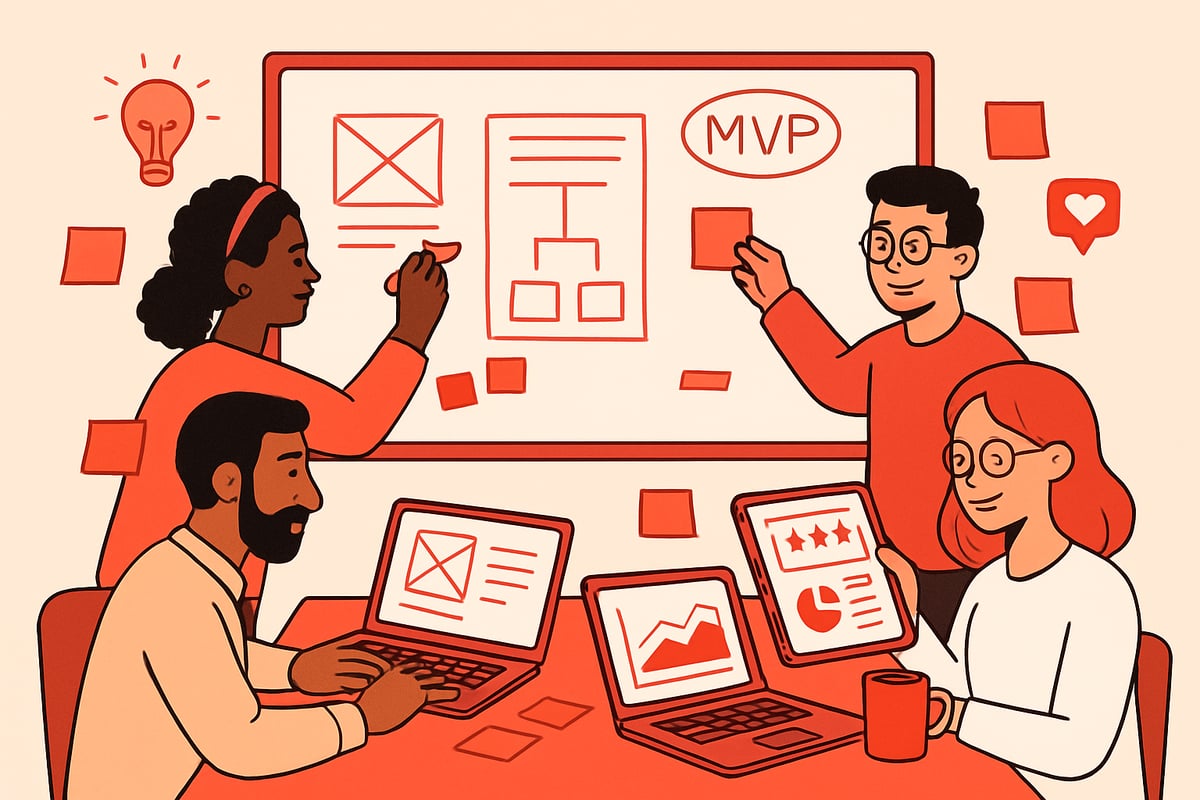Startup Technology Guide: Your Roadmap to Success in 2025
In 2025, making the right startup technology choices can mean the difference between breakout success and shutting your doors early. The landscape is moving fast, and every decision counts.
This guide gives you a clear, step-by-step roadmap to leverage startup technology for launching, scaling, and protecting your business. Whether you’re just starting out or looking to future-proof your growth, you’ll find actionable insights, must-have tools, and proven strategies.
We’ll cover everything from foundational planning and tech stacks to AI integration, cybersecurity, and emerging trends. Ready to build a winning startup? Let’s dive in.
Step 1: Laying the Foundation—Planning Your Startup’s Tech Strategy
Launching a successful startup begins with a sharp focus on your foundation. Every decision you make about startup technology in these early stages can shape your trajectory for years to come. The right groundwork empowers startups to adapt, scale, and thrive even in unpredictable markets.

Defining Your Startup’s Vision and Goals
Clarity of vision is the compass for every startup technology choice. Your long-term business goals should guide every tech decision, from product features to infrastructure. When vision and startup technology align, you can pivot with purpose, just as Slack did when it transitioned from gaming to enterprise communication.
Startups that lack this alignment often struggle. In fact, 90% of startups fail within 10 years, with misaligned strategy cited as a leading cause. Defining what you want to achieve helps you prioritize technology that supports your mission, ensures your team moves in the same direction, and sets the stage for sustainable growth. A clear vision is not just a statement—it is your north star.
Identifying Core Technology Needs
Mapping out your business processes is essential to pinpointing what startup technology is truly necessary. Start by listing your must-have solutions—these are the technologies that keep your operations running. For example, an e-commerce startup might prioritize secure payment gateways and robust inventory management.
Differentiate between essentials and nice-to-haves. While it is tempting to integrate the latest tools, focus on what directly supports your core offering. Ask yourself: what technology will deliver immediate value to your customers? This approach keeps your tech stack lean and effective during the crucial early stages.
- Identify core business processes
- Prioritize essential technology
- Evaluate solutions for scalability
Budgeting for Technology—Costs, ROI, and Funding
Budgeting is a balancing act for any founder. Estimate your startup technology expenses by considering hardware, software licenses, and personnel costs. Factor in both initial investments and ongoing maintenance.
Calculate your expected return on investment for each technology decision. This helps you allocate resources wisely and avoid overspending. Explore funding options such as bootstrapping, venture capital, or grants, depending on your needs and growth plans.
| Tech Expense | Initial Cost | Ongoing Cost | ROI Consideration |
|---|---|---|---|
| Software Licenses | $$$ | $$ per month | Productivity, automation |
| Hardware | $$$$ | $ (upgrades) | Reliability, scalability |
| Personnel | $$$ | $$$ | Expertise, innovation |
Nearly 29% of startups fail because they run out of cash, so careful budgeting and ROI tracking are essential.
Building Your Technical Team
Your technical team is the engine behind your startup technology. Decide whether to hire in-house, outsource, or use a hybrid approach. In-house teams offer dedicated focus and cultural alignment, while outsourcing can provide cost savings and flexibility.
Consider roles like CTO, developers, and technical advisors. For early-stage startups, hiring a fractional CTO can provide strategic guidance without a full-time commitment. Notion, for example, succeeded with a lean early team, focusing on agility and shared vision.
- In-house: Deep alignment, higher cost
- Outsourcing: Cost-effective, less control
- Fractional CTO: Strategic input, flexible engagement
The right team structure supports fast iteration and minimizes risk.
Creating a Tech Roadmap and Milestones
A clear tech roadmap organizes your startup technology journey into manageable phases. Set specific, measurable milestones for development, such as feature releases or user targets. Adopt agile methodologies to allow for quick adjustments and iterative progress.
Use visualization tools like Trello or Jira to track tasks, deadlines, and dependencies. Airbnb’s phased rollout is a classic example—by breaking down goals, they could adapt and scale with confidence.
- Define milestones for each tech phase
- Use agile sprints for flexibility
- Visualize progress with project management tools
Laying this groundwork ensures your startup technology can evolve, adapt, and lead the way as your business grows.
Step 2: Choosing Your Tech Stack—Languages, Frameworks, and Tools for 2025
Selecting the right tech stack is one of the most important decisions in startup technology. Your choices can supercharge your growth or create hurdles down the line. Let’s break down the essential elements you’ll need to choose wisely in 2025.

Evaluating Programming Languages and Frameworks
The foundation of your startup technology begins with the programming languages and frameworks you select. In 2025, backend favorites like Python, Node js, and Go dominate for their speed and scalability. On the frontend, React, Vue js, and Svelte offer flexibility and vibrant developer communities.
When deciding, consider factors like scalability, the size of the talent pool, and community support. Fintech startups often choose Python for rapid prototyping and access to machine learning libraries. Remember, aligning your stack with your market’s needs is key. For deeper insights, check out How to build a product people want to buy.
Cloud Platforms and Infrastructure Choices
Cloud infrastructure is now a non negotiable element of startup technology. AWS, Google Cloud, and Azure remain the top choices, but new European providers are emerging for startups focused on data sovereignty.
Should you go serverless or use containers like Docker and Kubernetes? Serverless offers simplicity and cost savings for early MVPs, while containers give you more control as you scale. With 94 percent of enterprises using cloud services, making the right infrastructure choice is crucial for both agility and future growth.
Essential SaaS Tools for Startups
No startup technology stack is complete without the right SaaS tools. Customer relationship management (CRM) platforms like HubSpot and Salesforce help track leads and sales. Project management tools such as Asana and Monday keep your team on track. Collaboration tools, including Slack and Notion, enable seamless communication.
Integration is crucial. Tools like Zapier can automate workflows between your favorite SaaS apps, freeing up time for your team to focus on innovation. The right SaaS ecosystem boosts productivity and enables rapid scaling.
Open Source vs. Proprietary Solutions
Choosing between open source and proprietary solutions is a pivotal startup technology decision. Open source options like WordPress or Magento offer flexibility, lower costs, and transparency. Proprietary platforms such as Shopify or Salesforce provide robust support and streamlined integration but can be expensive.
Buffer’s open source first approach fostered transparency and innovation, while other startups opt for proprietary solutions for mission critical operations. Weigh security, customization needs, and your team’s expertise before making a call.
Building for Scalability and Flexibility
Design your startup technology architecture with growth in mind. Microservices, where each feature is a separate service, allow you to scale specific parts of your product independently. Monolithic architectures are easier to start with but may become bottlenecks as user numbers climb.
Spotify’s microservices model is a great example of building for feature velocity. Use architecture diagrams and roadmap tools like Trello or Jira to visualize your scaling journey. Always anticipate growth, even in your earliest tech decisions.
Sustainability and Green Tech Considerations
Sustainability is now a core part of startup technology planning. Opt for energy efficient hosting and carbon neutral cloud providers to meet consumer demand for eco friendly brands. Regulations in Europe and beyond are pushing startups to consider their environmental impact from day one.
According to Nielsen, 80 percent of consumers prefer sustainable brands. By prioritizing green tech, you not only future proof your operations but also appeal to a broader, eco conscious market.
Step 3: Building and Launching Your MVP—From Prototype to Market
Turning your idea into a real product is the heartbeat of startup technology. The MVP, or minimum viable product, is your first leap from concept to market. It is the fastest way to test your assumptions, gather real feedback, and start building momentum.

Rapid Prototyping and MVP Development
The journey begins with rapid prototyping. Using tools like Figma, Sketch, or InVision, you can visualize your ideas before writing a single line of code. Startups often follow the Build-Measure-Learn loop of lean methodology to create MVPs that deliver just enough value for early adopters.
A standout example is Dropbox, which famously launched with a simple explainer video to validate demand before building out their full platform. Your startup technology should focus on solving the core problem with the simplest solution possible.
For a deeper dive into how MVPs fit into the bigger picture, check out Four steps to building a great product, which breaks down each phase of the product journey.
User Testing and Feedback Loops
After your MVP is live, user feedback becomes your compass. Use surveys, interviews, and built-in analytics to capture insights on what works and what does not. The best startup technology teams set up continuous feedback loops, allowing for quick iteration.
According to Y Combinator, startups with solid feedback systems are 2.5x more likely to hit product-market fit. Tools like Typeform, Google Forms, and session recording apps make gathering feedback seamless. Prioritize actionable insights over vanity metrics.
Short, focused improvement cycles help you respond to the market and keep your startup technology aligned with user needs.
Launch Strategies and Go-to-Market Tech
Launching your MVP is a milestone. Choose platforms like Product Hunt or BetaList to reach early adopters who love testing new startup technology. Consider a soft launch or invite-only access to manage growth and collect valuable data.
Leverage A/B testing tools and launch analytics to see what resonates. Clubhouse, for instance, grew buzz with its invite-only approach, ensuring a controlled, scalable rollout. Track signups, engagement, and feedback from day one to refine your go-to-market strategy.
A thoughtful launch plan can turn your MVP into a launchpad for future success.
Integrating Analytics and Performance Monitoring
Once your MVP is in users’ hands, analytics become your guide. Track key metrics like daily and monthly active users (DAU, MAU), churn, retention, and conversion rates. Startup technology shines when it translates data into smarter decisions.
Popular tools include Google Analytics, Mixpanel, and Amplitude. Set up dashboards to monitor real-time performance and spot trends early. Use this data not just to report, but to drive product tweaks and prioritize features.
Data-driven decisions keep your startup technology agile and focused on what matters most to users.
Scaling Post-Launch—Iterate or Pivot?
With your MVP in the wild, the next challenge is scaling. Look for patterns in your data—are users sticking around or dropping off? Sometimes, the answer is to double down and scale infrastructure. Other times, it is time to pivot.
Twitter started as a podcasting platform before pivoting to microblogging after seeing where user interest lay. Startup technology should empower quick shifts when needed, whether that means adding features, changing direction, or rethinking your core value.
Stay flexible, keep listening, and let the market guide your next move.
Step 4: Leveraging AI, Automation, and Next-Gen Technologies
Embracing AI, automation, and emerging tech is not just a trend for startups in 2025. It is a necessity. With the rapid pace of change, leveraging startup technology strategically can mean the difference between scaling fast and falling behind. This step explores the most impactful ways to future-proof your business.

Integrating AI and Machine Learning
AI is revolutionizing how startups operate, from personalized user experiences to advanced analytics. In 2025, integrating AI into your startup technology strategy can unlock new opportunities for growth and efficiency. Use cases include:
- Personalization engines that adapt content or products to user preferences
- Recommendation systems in e-commerce, media, or SaaS
- Predictive analytics for sales, churn, or inventory
Accessible platforms like OpenAI, Google AI, and Hugging Face make it easier than ever to experiment and deploy AI models. The AI market projected to grow at 37.3% CAGR highlights why founders must invest in these tools to stay competitive. Prioritizing AI within your startup technology stack can help you deliver smarter products and scale more quickly.
Automation for Efficiency and Growth
Startup technology should streamline operations, not complicate them. Automation is key to achieving this goal. By automating repetitive tasks, founders free up time for innovation and growth. Popular automation applications include:
- Marketing automation for email, social media, and lead nurturing
- Customer support automation with chatbots and self-service portals
- Operations automation, such as invoicing and onboarding
Tools like Zapier, UiPath, and Intercom help connect workflows across different platforms. For example, chatbots have been shown to reduce support costs significantly, allowing your startup technology to create more value with fewer resources.
Blockchain and Web3 Opportunities
Blockchain is shifting the paradigm for digital trust, transparency, and decentralization. In the context of startup technology, blockchain offers solutions like:
- Decentralized apps (dApps) that remove intermediaries
- Smart contracts for secure, automated transactions
- Tokenization for new business models and fundraising
Startups in Switzerland are already applying blockchain to digital identity and compliance. However, regulatory considerations are evolving, so it is crucial to stay informed and ensure your startup technology is compliant from day one.
AR/VR and Immersive Tech for Startups
AR and VR are transforming customer engagement and product development. For startups, adopting immersive startup technology can mean:
- Enhanced training simulations for employees
- Interactive product demos for customers
- Immersive marketing experiences at events or online
With hardware like Meta Quest and Apple Vision Pro, and a rapidly growing market, AR/VR is becoming more accessible. Startups that embrace this technology early can stand out in crowded markets.
Staying Ahead: Continuous Learning and Tech Adoption
Startup technology evolves quickly, so continuous learning is essential for founders and teams. Invest in:
- Online courses on AI, blockchain, and automation
- Tech meetups and industry conferences for networking and insights
- AI-driven learning platforms to upskill your workforce
Encouraging your team to explore new tools and trends ensures your startup technology remains cutting-edge. This culture of learning helps you adapt and thrive, no matter how the landscape shifts.
Step 5: Cybersecurity and Data Protection for Startups
In 2025, cybersecurity is not a luxury—it is a necessity for every startup technology venture. As digital threats grow more sophisticated, founders must make security a core part of their strategy from day one. Failing to do so can put your business, data, and reputation at serious risk.
Understanding the Threat Landscape in 2025
The threat landscape facing startup technology companies is evolving rapidly. Ransomware, phishing, and supply chain attacks are on the rise, targeting small businesses just as aggressively as large enterprises. The financial and reputational damage from a breach can be devastating—60% of small companies close within six months of a cyberattack, according to the NCSA.
Investors are taking note, with cybersecurity funding increased to $2.7 billion in Q1 2024, signaling its growing importance. For any startup technology business, understanding these risks is a critical first step in building resilience.
Building Security into Your Product from Day One
Security should be woven into the DNA of every startup technology product. Start with secure coding practices—conduct regular code reviews, use automated tools like Snyk or GitHub Dependabot, and stay updated on the latest vulnerabilities through OWASP resources.
For regulated industries such as fintech, security is not just a best practice, but a legal requirement. Involving technical advisors or a security specialist early can help you design with protection in mind. Proactive measures now save time, money, and stress down the line.
Compliance and Data Privacy Regulations
Navigating compliance is a major challenge for any startup technology venture. Regulations like GDPR, CCPA, and emerging 2025 policies demand strict data handling, privacy policies, and user consent mechanisms. Healthtech startups often face dual compliance, such as HIPAA and GDPR, requiring extra diligence.
If you are just starting out, reviewing legal basics for startups can help clarify what rules you must follow. Early compliance planning helps avoid costly penalties and builds customer trust from day one.
Security Tools and Best Practices for Startups
Equipping your startup technology team with the right security tools is essential. Essentials include:
| Tool Type | Example Solutions |
|---|---|
| Firewalls | pfSense, Fortinet |
| Endpoint Protection | CrowdStrike, Bitdefender |
| MFA | Authy, Google Authenticator |
| Encrypted Storage | VeraCrypt, AWS KMS |
Employee training and phishing simulations are just as important as software. Remember, multi-factor authentication can prevent 99.9% of account hacks, according to Microsoft. By embedding security habits early, your startup technology foundation will be far stronger.
Step 6: Future-Proofing—Trends and Technologies to Watch in 2025
Staying ahead in the world of startup technology means keeping an eye on the trends shaping tomorrow’s landscape. In 2025, founders face a rapidly shifting environment where the right tech choices can unlock massive opportunity. The global tech industry is now valued at over $5.3 trillion, making it more vital than ever for startups to future-proof their strategies. Let’s explore what’s next.
The Rise of No-Code and Low-Code Platforms
No-code and low-code tools are transforming startup technology by making app development accessible to everyone. Founders no longer need deep technical skills to build products or automate workflows. Platforms like Bubble, Webflow, and Airtable allow rapid prototyping and iteration, letting teams validate ideas quickly.
The impact is huge: Gartner predicts that 65% of all app development will be low-code or no-code by 2025. This shift democratizes innovation, enabling non-technical founders to bring bold ideas to life. For startups, leveraging these tools can mean faster launches, lower costs, and the flexibility to pivot as markets change.
Edge Computing and IoT Integration
Edge computing and IoT are revolutionizing real-time data processing in startup technology. Instead of sending all information to the cloud, edge devices analyze data locally, allowing instant decision-making. This is a game-changer for industries like logistics, manufacturing, and healthcare, where every second counts.
Swiss logistics startups, for example, are deploying IoT sensors to track shipments and monitor conditions throughout the supply chain. By integrating edge computing, startups can offer smarter, faster services while reducing latency and bandwidth costs. As IoT adoption grows, expect more startups to harness these tools for competitive advantage.
Quantum Computing—Hype or Reality for Startups?
Quantum computing is one of the most exciting frontiers in startup technology. While it is still early days for widespread adoption, quantum breakthroughs are on the horizon. Startups exploring this space are working on solutions for cryptography, complex simulations, and AI acceleration.
Investment in quantum startups is rising, and pilot projects are emerging in sectors such as finance and pharmaceuticals. However, most startups should view quantum as a long-term opportunity rather than an immediate must-have. Keeping an eye on this trend ensures your team is ready when quantum becomes more accessible.
Building a Culture of Continuous Innovation
Future-proofing your startup technology goes beyond tools, it is about fostering a mindset of experimentation. The most successful startups encourage learning from failure, run regular innovation sprints, and host hackathons to spark creativity.
Companies that prioritize innovation programs outperform peers by 30%. A strong culture also means building a community around your vision. As explored in Building a startup community first, your technology choices can help attract talent, partners, and early adopters who drive growth. Make innovation a habit to stay ahead in 2025 and beyond.
You’ve just explored the essential steps to building a tech-driven startup ready for success in 2025—from picking your tech stack to staying ahead with the latest trends. But the real magic happens when you connect with others on the same journey, sharing ideas and learning from those who’ve been there. If you’re looking for hands-on support, fresh perspectives, and a community that truly gets what it takes to launch and scale a startup in Switzerland, why not take the next step? Apply to our swiss founders community and join a network of driven entrepreneurs shaping the future together.

